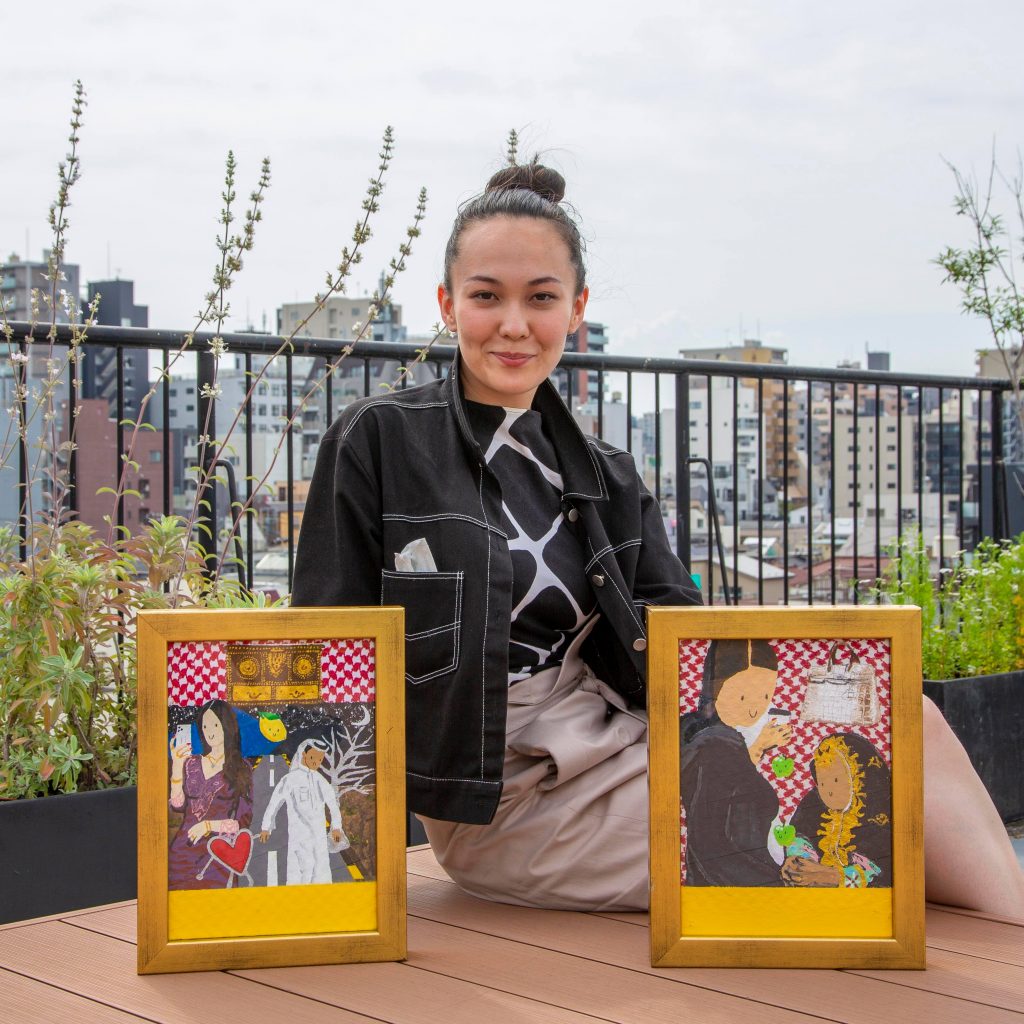
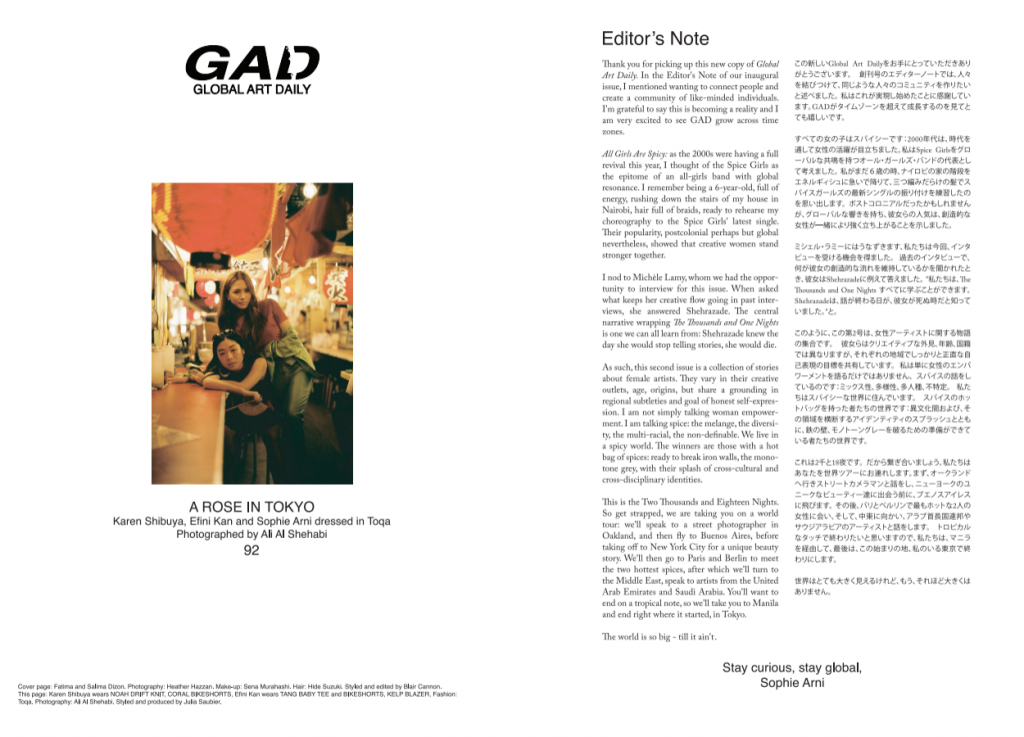
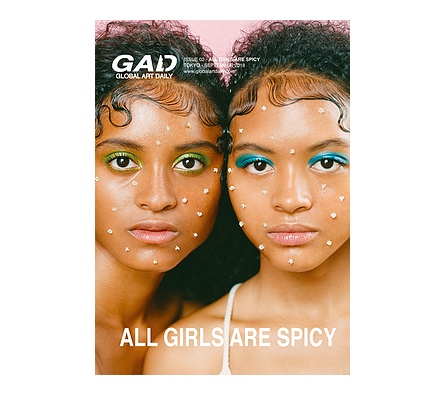
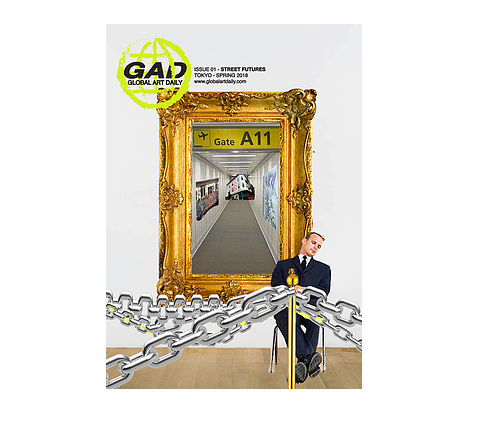




Carla Chahrour
In the year 2021, it is unlikely that any one nation can state that it is utterly and completely self- sufficient and independent, but rather, each nation depends on the contributions and innovations of other countries, a notion that helps illustrate the concept of globalization. Globalization has become a characteristic feature of this modern day. Its effects have spread from fashion to art.
With globalization, new countries have increased their presence in the art market leading to a newly distributed visibility. While the United States and the European Union confirm their high trends in contemporary art, new artists from the Arabian Gulf and Japan, amongst others, have quickly enlarged and diversified the field.
In an exclusive interview with Arab News Japan, the Founder and Editor-in-chief of Global Art Daily Sophie Mayuko Arni discussed the inspiration behind the publication, the polycentric art world including her cross-national and cross-cultural observations with specific focus on the convergences and divergences concerning art in the UAE and Japan.
The publication “Global Art Daily” reports on contemporary art happenings from multinational perspectives. For Arni, the art world today cannot be studied from an isolated regional viewpoint: the art industry is characterized by the rise of international art fairs and biennales, social media cross-border exchanges, and greater mobility for artists and curators. By fostering contributions from emerging art critics in the Arabian Gulf and Asia, she hopes to promote a new generation of art critics outside the established centers of the art world.
As a daughter of a diplomat and humanitarian, Arni, who is half-Japanese and half-Swiss embodies the term “third-culture kid” as she was an expatriate that spent most of her formative years overseas, shaped by the multicultural, peripatetic spheres of her parents.
“I grew up traveling, following my father’s career who use to work for the International Red Cross and now works for the United Nations since a very young age. Growing up we travelled every four years to a different country. So I’m half Swiss and half Japanese, but I grew up between the Middle East, Eastern Europe, and Africa,” Arni said.
“The whole thing was confusing when I was little. I didn’t understand why I had to leave while my friends stayed behind, or why I had to learn new customs and traditions. As one can imagine with all that travelling, questions about identity kept piling up, and when you’re a child you don’t realize you’re in it. But then when you hit 18 and you go to university, you start to question where you are from and what national identity you belong to. This was a very, very difficult question to answer for me,” Arni said.
While the idea that a sense of belonging is challenged by the straddling of cultures is hardly a revelation, having to relocate frequently and get enrolled in international schools, exposed Arni to miniature realms cultivated by peers from nations far and near, whose languages and customs coalesced to give birth to a “third” culture within her that was variegated, globe-spanning, highly empathetic and often onerous to translate outside these environments.
It’s for this reason that Arni attempted to unpack iterations of this experience — through delving into the global art world and pulling back the curtain on the art scene in the Middle East by sharing exhibition reviews from multiple perspectives as well as the experiences of emerging artists, whose place in the world now feels both more tenuous and important than ever before.
Upon graduating from high school in Geneva, Switzerland, Arni developed a keen interest in art, fashion and fine arts, which was partly influenced by her mother, who is a painter that also teaches painting. In 2012, Arni moved to the United Arab Emirates to attend the New York University in Abu Dhabi, where she majored in Art History. According to Arni, the decision to move to the UAE was due to being impressed with the university’s mission of educating the future generation of global leaders and the existence of a multicultural environment within the institution.
“Prior to attending the university I remember trying to learn more about the UAE and Abu Dhabi, because although I knew a little bit about the country, and this region as a whole. I did some research online and stumbled across a series of presentations and videos about future plans, I became attracted to the country’s vision,” Arni said.
“This made me realize that this is a city that has so much potential. It has been blessed with resources and its leadership seems so refreshingly ambitious for this world. While I love Europe and enjoyed all the places that I’ve lived in, I felt that there was this sense of newness that really only existed in the Gulf, almost like a blank slate to make things happen, especially in the cultural scene,” Arni added.
Inspired by her time in the cultural capital of Abu Dhabi, Arni launched her own independent publication Global Art Daily, while she was an undergraduate, to amplify the local voices of the global art world, with the aim of shedding light on contemporary art in the UAE, the Middle East, Asia, Europe, United States, and Latin America.
Arni describes the four years in which she lived in Abu Dhabi as “extremely formative” due to the exposure she attained through learning about art in the Arab world and the development of her passion for global art.
“During my four years in Abu Dhabi I got exposed to art in the Arab world, studied a lot of artists from the Levant and from the Gulf. The curriculum at NYUAD really focused on deconstructing the Western narrative of Art history and really focused on what “global art” means. These are all questions that are asked by curators at art museums, like “how can we create a contemporary art history that is polycentric – that has multiple geographical view points represented?” Arni said.
In line with the progressively converging and integrating world of art, Arni utilized her multicultural identity, which was increasingly encountering cultural diversity, within her art to help in the navigation of different cultural identities and in turn, provide a cross-cultural context perspective of her observations.
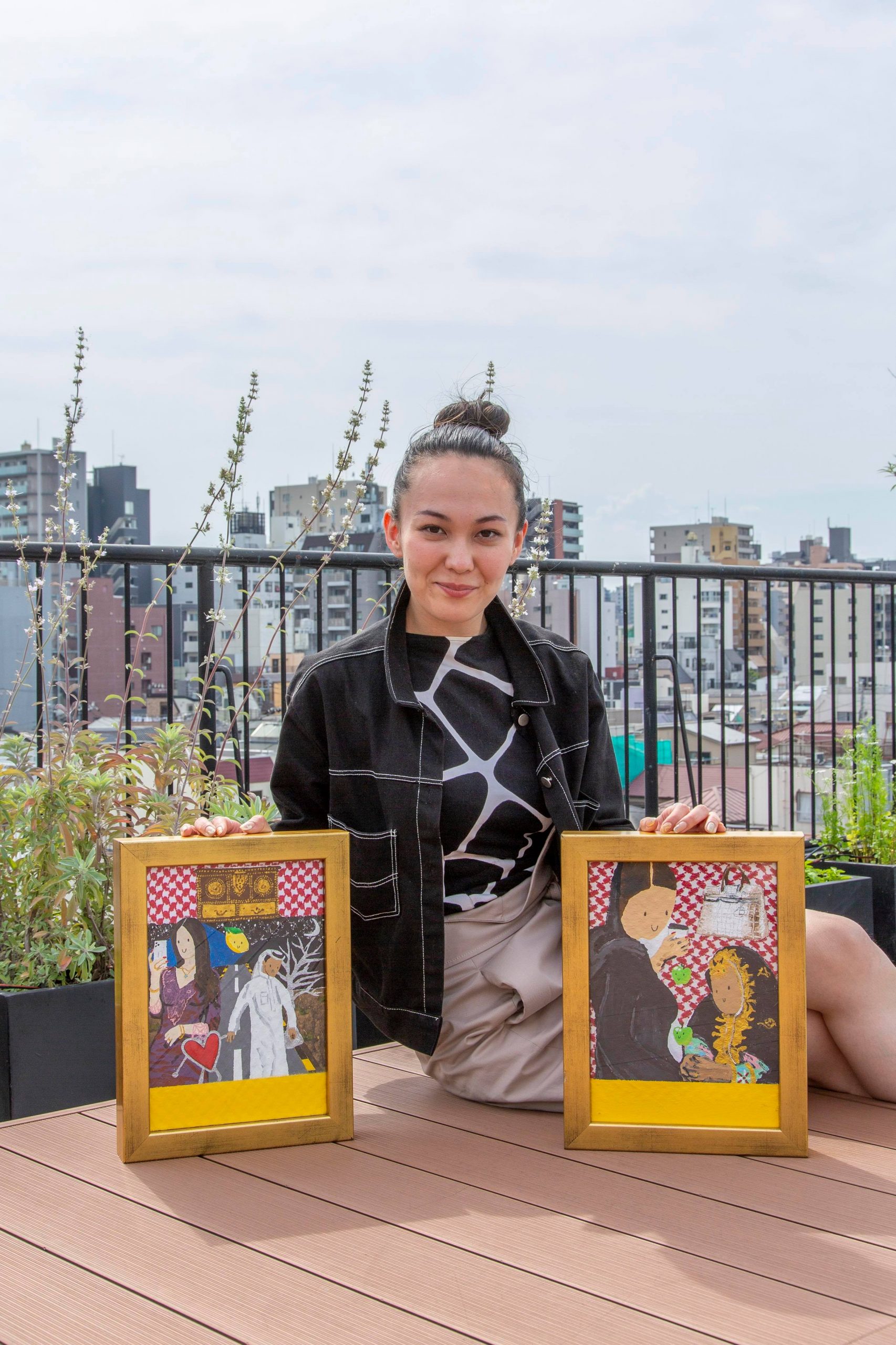 Founder, Editor-in-Chief and Curator Sophie Mayuko Arni with Salman Al Najem paintings. (Supplied)
Founder, Editor-in-Chief and Curator Sophie Mayuko Arni with Salman Al Najem paintings. (Supplied)“The word “global art” kept coming up and I wanted to create some kind of blog where I could document what I was seeing because I was going to a lot of exhibitions for my classes and writing exhibition reviews. Around that time I also got more and more interested in contemporary art and the emerging artists my age, both Emirati and UAE-based artists. So I created this blog in 2015 and I started to interview them,” Arni said.
“Additionally, being in a university that attracts so many nationalities was hugely inspiring. We had around 110 nationalities represented in a small cohort where we would all congregate in Saadiyat Island (in Abu Dhabi), where we felt part of the cross-continental NYU network. Students also had the opportunity to study away in different cities such as New York, Paris and Shanghai so we would all come back and discuss those experiences. I decided to expand the platform by getting contributors from the school that were visiting these cities and invite them to write exhibition reviews and conduct interviews with artists,” Arni added.
Arni took advantage of the unique cultural diversity she was surrounded with and grew the platform to include features from cross-cultural exchanges in art that were obtained through different lenses and perspectives, which was made possible by the inclusion of fellow students.
“We ended up with contributors based in Shanghai, Buenos Aires, New York City, and Abu Dhabi who all wrote about their respective art scenes. This got me thinking about how I could create this true trans-continental network of young people who are interested in art. We all come from different perspectives as well. I studied art history, but other editors in our team have studied in vastly different fields. For example, one of our writers studied Arab Crossroads and is now completing a PhD in Middle Eastern Studies, and he brings an academic, historical point of view, another studied film and helps with the creative aspects of the publication,” Arni said.
“For me, “global” really means two things. One is global in the geographical sense, thinking of how we can have cross-cultural bridges. But also global in that it is not just about the fine arts world. I see it more and more where artists aren’t just traditional artists whose work is exhibited in prestigious museums, but those creating art digitally on Instagram, or working across a variety of media, such as music and fashion. Creativity today involves seeing all the connections between the different categories, unlike the traditional, separated approach, which is very euro-centric. Throughout the history of museums, everything from painting, science, draws a clear distinction between painting and sculpture on one side, and decorative arts on the other. Abu Dhabi provided me with that blank slate that I was searching for and I was very much inspired,” Arni said.
GAD has since developed into an independent web and print publication, launching two printed issues of magazines in Japan. The publication’s E-Issues, which can be found on their website, are published bi-annually, each with a theme that centralizes a different city. Although it primarily focuses on emerging artists through the provision of exhibition reviews and interviews, it also integrates more renowned artists with more experience to fulfill an underlying purpose of the publication, which is building bridges between different artists, creative disciplines and cities.
Meanwhile, the print version of the publication is present internationally in selected bookstores specializing in art, including Tsutaya, Japan’s biggest bookstore.
The creation of a magazine that was printed in Tokyo attracted the public’s attention and helped the magazine find itsniche audience of emerging artists that are interested in having a global outlook or are curious about other cultures.
“We specialize in very in-depth and researched articles through the conduction of very personal interviews with artists. I think we serve a niche audience that are really working or very much passionate about the art world,” Arni said.
The main aspects differentiating GAD from other magazines is the cultural diversity achieved through its multifaceted artistic environment that is not bound to a particular region and its devotion to editorial integrity in the provision of authentic articles that are conspicuously written by educated contributors across disciplines to allow readers to interpret the significance of the artworks.
In addition to her role in GAD, Arni highlighted one of the exhibitions she curated titled “East- East: UAE meets Japan” which is an exhibition series that started in 2016 and was first held in the NYU Abu Dhabi Project Space.
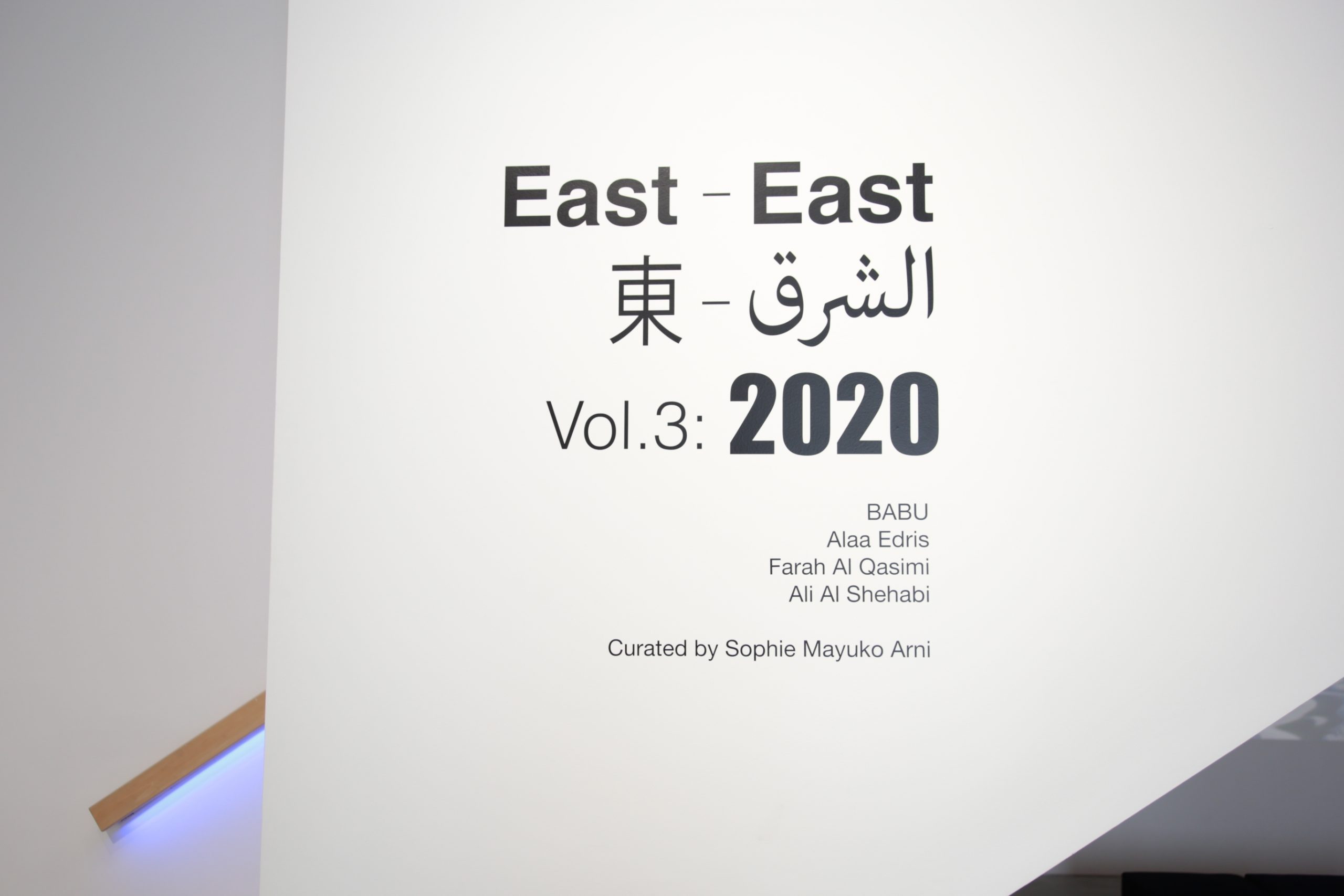 East- East: UAE meets Japan curated by Sophie Arni at the NYU Abu Dhabi Project Space, Oct. 2016. (Supplied)
East- East: UAE meets Japan curated by Sophie Arni at the NYU Abu Dhabi Project Space, Oct. 2016. (Supplied)The idea of the exhibition was to bridge the UAE and Japan through emerging artists with the aim of drawing parallels between the rapid modernization of Japanese and Emirati traditional societies.
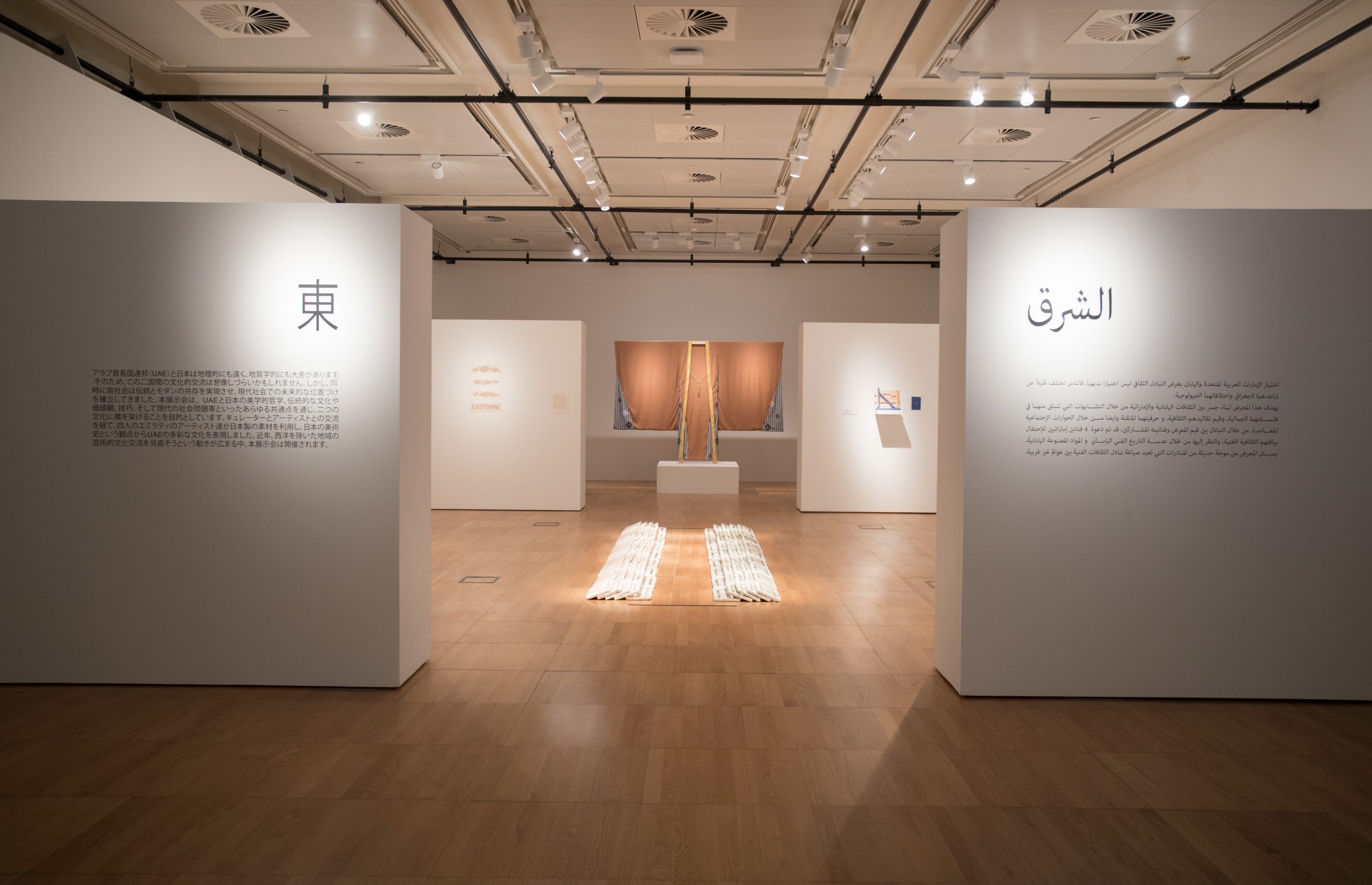 East- East: UAE meets Japan curated by Sophie Arni at the NYU Abu Dhabi Project Space, Oct. 2016. (Supplied)
East- East: UAE meets Japan curated by Sophie Arni at the NYU Abu Dhabi Project Space, Oct. 2016. (Supplied)The spectacularization of this transformation demonstrated in the exhibition served to show how both cultures attempted to maintain a balance between modernism and heritage.
The dichotomy associated with such a dynamic approach shows the similarities in both urban spectacles that attempt to go beyond mere capital accumulation to include the deeply embedded social and cultural values that simultaneously exist underneath the economic success of Japan and the UAE. Arni also wanted to create avenues for a new generation of artists to engage in cross-cultural dialogues between East Asia and the Arabian Gulf.
Having been immersed in the art scenes of both Tokyo and Abu Dhabi, Arni explained that
while artists have different traditions in representing the world in their artwork, which trace back to their cultural trajectories, interesting parallels can be observed. The implicit application of cultural patterns of artistic expression from their own cultures, artists from the Arabian Gulf and Japan tend to display similarities that stem from their rapid development and similar attachment to their traditional and social norms.
Arni highlighted that such similarities can be observed in the work of Ahmed Alanzi, a Dubai-based artist, in the 2016 East-East: UAE meets Japan exhibition.
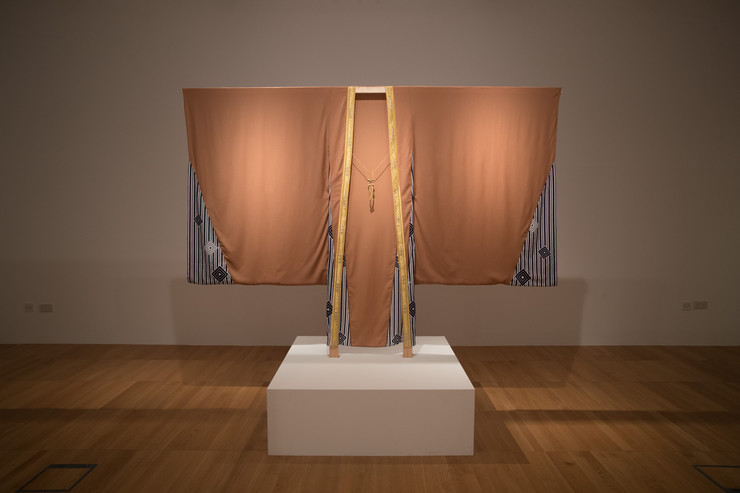 Ahmed Alanzi’s “Kibimosht” displayed at the East- East: UAE meets Japan exhibition curated by Sophie Arni at the NYU Abu Dhabi Project Space. (GAD)
Ahmed Alanzi’s “Kibimosht” displayed at the East- East: UAE meets Japan exhibition curated by Sophie Arni at the NYU Abu Dhabi Project Space. (GAD)Alanzi’s work combined the ideas of national pride and traditional costume in the Arabian Gulf and Japan through the creation of a sculptural garment named the “Kibimosht” that fuses the bisht, which is the traditional long cloak that men from the Arabian Gulf wear for special occasions and the kimono, which is worn by both men and women in Japan during special occasions.
Arni continued to set up exhibitions that bridge the two countries together through different aspects of their corporate-capitalist urbanization process compounded with inter-referential connections to their heritage in two subsequent volumes in the UAE.
The fourth and most recent iteration of the “East-East: UAE meets Japan” exhibition series titled “East-East Vol.4: The Curio Shop” debuted in Tokyo during June this year with a similar aim of bridging the two countries together by featuring the works of fifteen artists from the Arabian Gulf and Japan.
“”Curios”, a 19th-century abbreviation for “curiosities,” used to describe works of fine craftsmanship sold in Japan to early foreign settlers in late 19th century Japanese port cities,” Arni explained in a press release.
“This exhibition will aim to present a contemporary and youth-led version of a cabinet of curiosities blending these two geographies in an East-East context,” she added.
The inclusion of non-Western geographies into the art canon through the creation of an exhibition that showcases artists from the Arabian Gulf and East Asia, Arni has helped to define a more inclusive context for art production and presentation.
Discussing changes she would like to see happen in the art world, Arni alluded to the need to see more diversity and to the concept of hybridity.
“Although it is already happening, given the social movements that have been taking place, the changes I would like to see would be more diversity and more representation of dialogues between non-Western art scenes,” Arni said.
“We have finally turned the page on the idea that an art museum should be a certain way and we are entering a new cultural sphere where artists are providing diverse shows, in terms of the production of art from different mediums, and the presentation of not just paintings but film, music and fashion. The new status quo should be hybridity, the mixing of cultures and creative disciplines,” Arni added.
The hybridity being referred to by Arni includes redefining what the public interprets as “art” and changing art from being understood in its most conventional, Western sense, as an occupationally specialized practice.
In taking charge of creating new models for art initiatives through the decentralization of Eurocentric art historical approaches, GAD was able to produce a publication that constitutes a transient utopian convergence of intellectuals which, though reflecting both traditional academic disciplinary and interdisciplinary interests, has exhibited how globality has modified traditional understandings of contemporary art production, art writing, and transcultural aesthetics worldwide.